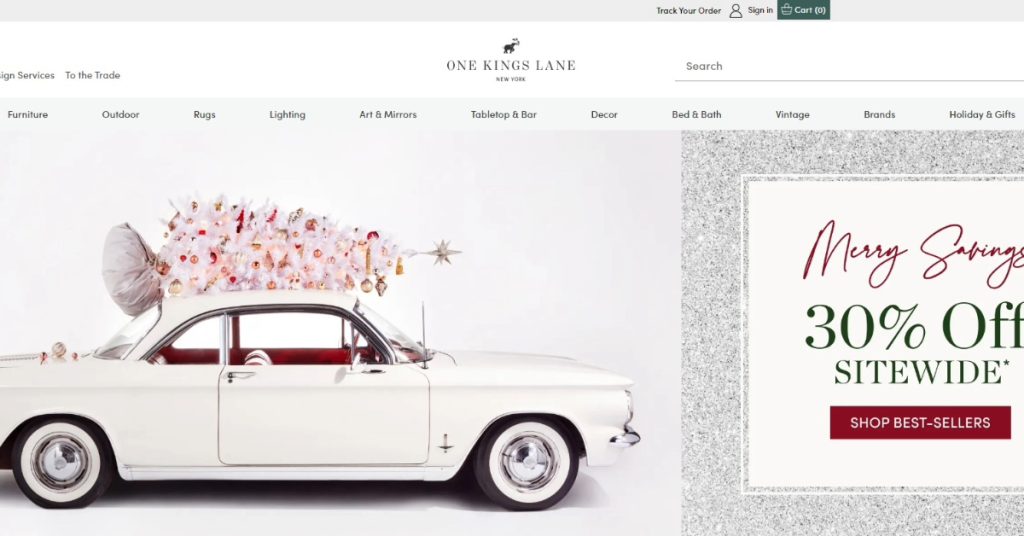
One Kings Lane marketplace case study: book a demo to start yours
One Kings Lane is an internet-based store that focuses on luxury furniture, home embellishments, and decor, presenting carefully selected assortments and designer products for those passionate about interior design. If you’d like to start your own marketplace like One Kings Lane, you’re facing a buy vs build decision. So before you decide to build it in-house on top of Spree open-source, consider using the feature-rich Enterprise Edition cutting your time-to-market to a few weeks.
Build vs Buy a marketplace?
Open-source has its share of advantages, like total ownership and the freedom to customize. Yet, these perks often involve considerable costs. Developing a complete marketplace solution is a time-consuming and expensive task, usually taking months or years, as we have learned from multiple marketplace projects.
If speed and reliability are your priorities, choosing a pre-built, enterprise-ready solution like Spree Commerce Enterprise Edition is the practical path forward—backed by the experience of those who know how unpredictable and risky custom marketplace development can be.
Back to the One Kings Lane marketplace case study
One Kings Lane, an online home decor and furnishings marketplace, embarked on a remarkable journey from its inception as a startup to becoming a leader in the industry. Founded in 2009 by Susan Feldman and Alison Pincus, this e-commerce platform gained traction through its flash-sale model, offering high-end home goods at discounted prices.
The company’s success lay in its ability to curate an exclusive selection of designer furniture, decor, and accessories, enticing customers with limited-time sales that cultivated a sense of urgency and exclusivity.
Despite its initial success, One Kings Lane faced challenges, notably during the era when flash sales started to wane in popularity. The company adapted its strategy by diversifying its offerings beyond flash sales to include a broader assortment of full-priced products and launching Vintage & Market Finds, a marketplace dedicated to unique and vintage items, to cater to changing consumer preferences.
However, the journey of One Kings Lane was not devoid of difficulties. In 2016, the company encountered financial struggles, leading to its acquisition by Bed Bath & Beyond. This acquisition aimed to leverage the strengths of both companies and combine their resources to create a more robust retail entity.
Through its ups and downs, One Kings Lane’s story stands as a testament to the evolving landscape of e-commerce. Its ability to adapt its business model, diversify offerings, and navigate challenges showcases the resilience required to thrive in the competitive online retail sphere, offering valuable lessons to aspiring entrepreneurs and businesses within the industry.
How to emulate One Kings Lane marketplace success?
In pursuit of success like One Kings Lane’s, contemplate setting up your marketplace promptly, in a few weeks rather than waiting months. It’s vital to test how well your product catalog meets your audience’s needs and revise your customer acquisition tactics according to real results.
Initially, test the market before investing heavily in building it.
Here’s how to get started:
- Book a marketplace demo call: We’ll help you evaluate Spree for your marketplace needs and get started with the Enterprise Edition
- Customize your Storefront: Use the drag & drop page builder or custom CSS
- Onboard Brands: Invite your brands or choose brands from our catalog
- Select Products: Curate products and collections manually or automate it
- Embed products: Make your content, newsletters, social media shoppable
- Get Paid: Get paid as soon as products are shipped by the brands
- End-to-end automation: brands sync, fulfillment, payouts, invoicing, taxes
When you’ve tried all that and it works, start thinking about building your own, custom-made marketplace project based on Spree Commerce. First, by decoupling the storefront and going headless with marketplace API, and later with your own backend, if you decide you really need it. Just lift and shift the storefront.
Nobody has to know what’s under the hood, right?



